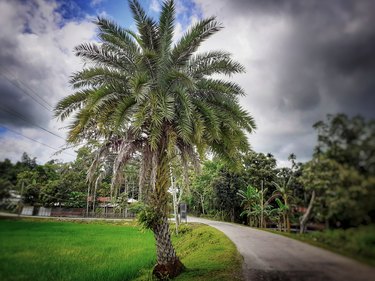
Native to southern areas of Pakistan and India, Sylvester palms (Phoenix sylvestris, U.S. Department of Agriculture plant hardiness zones 9 through 11) also go by the common names wild date palm, India date palm and sugar date palm. The slow-growing palm tree works well as an eye-catching specimen and definitely adds a tropical flair wherever planted. Generally a hardy tree, Sylvester palms planted in preferred conditions and given appropriate care produce the healthiest and most problem-free growth.
Sylvester Palm Noteworthy Characteristics
Video of the Day
Sylvester palm trees closely resemble their cousin the Canary Island palm tree (Phoenix canariensis, zones 9-11) but have thinner trunks. Mature trees can grow up to 60 feet tall with a canopy width of up to 40 feet. The palm only puts on around 1 to 2 feet of new growth yearly. Due to the palm's ultimate size, it can overpower a smaller landscape and is better suited for larger yard spaces.
Video of the Day
Stiff, bluish-green, feathery fronds grow around 10 feet long and their 3-foot-long stems are lined in tough, sharp thorns. Each frond's leaflets can grow around 18 inches long. The slightly arching fronds form into a dense canopy that is quite showy. These trees have an evergreen habit, meaning they do not shed their fronds in any particular season. The fibrous trunk is brownish-green and displays the triangular-shaped scars of once-attached fronds.
In spring, an inflorescence blooms about 3 feet long with whitish-yellow flowers. The spent flowers then form into oblong, 1-inch orange fruit clusters. Once ripe in fall, the fruits change to red and purple. The date fruits are edible and are typically used to make sugar in India. Sylvester palms shouldn't be confused with date palms (Phoenix dactylifera, zones 9-11), from which commercial dates are harvested.
Preferred Conditions for Good Growth
Sylvester palm trees are hardy in climates where temperatures don't dip below 15 degrees Fahrenheit. Due to the tree's ultimate mature size, it won't perform well when permanently grown in containers. Although it will grow for a while in a container, eventually it requires planting in the landscape. If holding the palm in a container before planting, be sure the pot has bottom drain holes to prevent rot problems.
The palm grows best planted on a full-sun site. Although Sylvester palms tolerate growing on a wide range of soils, including calcareous and sandy, loamy soils that drain well produce the best growth. If growing the palm briefly in a pot, use a potting mix that drains well.
When selecting a planting site, consider the palm's mature size and don't plant where it will interfere with power lines or a structure. Additionally, remove any unwanted weed or grass growth from the site and clear an area that is at least 3 feet in diameter.
Sylvester Palm Continued Care
Although tolerant of drought, regular water applications produce the best growth. Depending on local weather conditions, water newly planted Sylvester palms several times weekly until the tree establishes itself on the planting site. Once established, weekly water applications during the growing season are sufficient. In winter, when growth slows, water every couple of weeks.
Since the palm continues to gain nutrients from fronds that have even slight color, only prune fronds that are completely dead and brown. Due to the sharp thorns, be sure to wear protective clothing and gloves. You can prune off the developing flower or fruit stalks at any time without affecting the palm's health.
Fertilize twice during the growing season with a blend specific to palm trees, watering thoroughly after applying. Sylvester palms are susceptible to lethal yellowing disease, so don't plant the palm if your area is prone to the disease, as there is no cure.